Hyundai Equus 2016 Owner's Manual
Manufacturer: HYUNDAI, Model Year: 2016, Model line: Equus, Model: Hyundai Equus 2016Pages: 477, PDF Size: 16.25 MB
Page 311 of 477
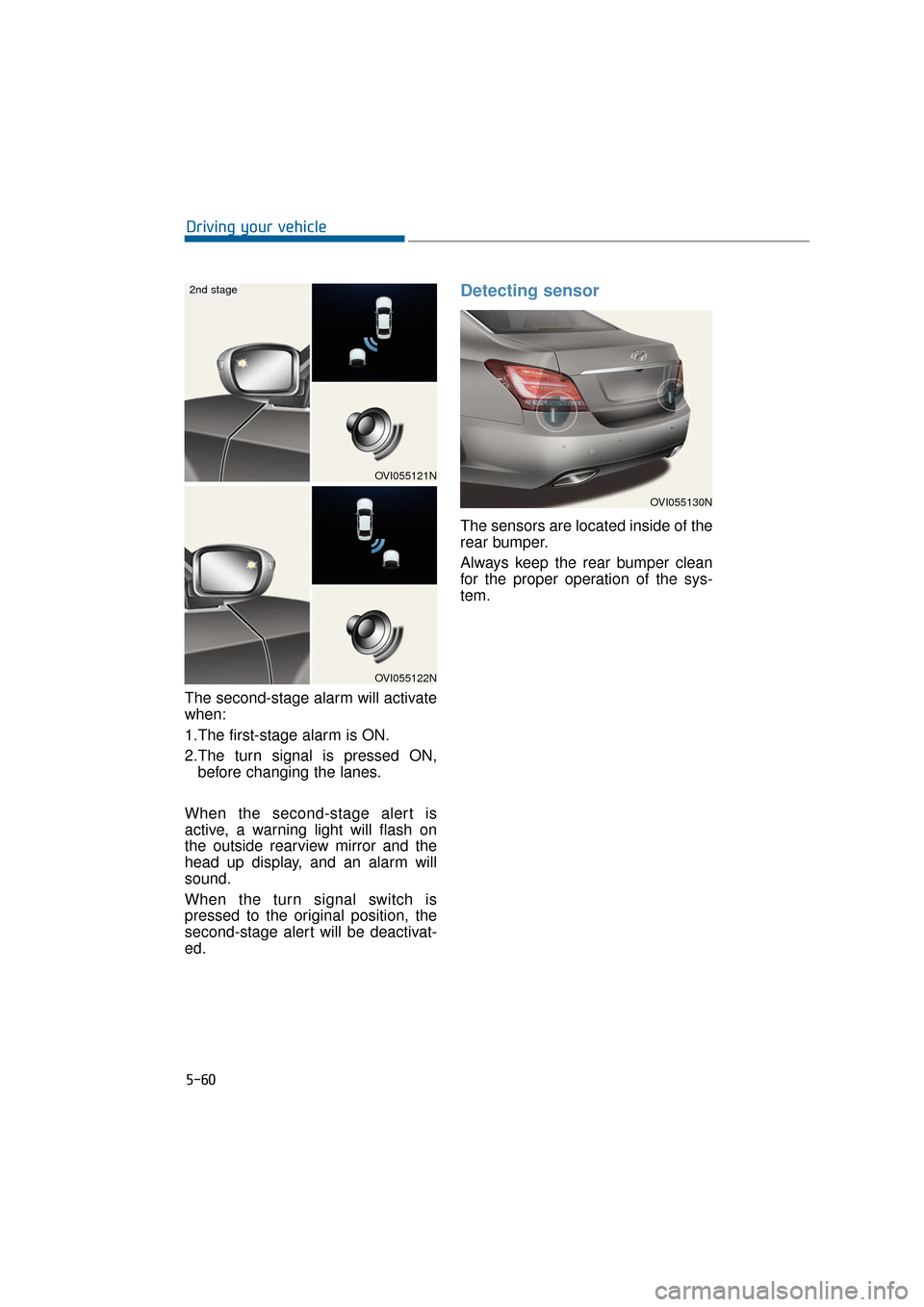
The second-stage alarm will activate
when:
1.The first-stage alarm is ON.
2.The turn signal is pressed ON,before changing the lanes.
When the second-stage alert is
active, a warning light will flash on
the outside rearview mirror and the
head up display, and an alarm will
sound.
When the turn signal switch is
pressed to the original position, the
second-stage alert will be deactivat-
ed.
Detecting sensor
The sensors are located inside of the
rear bumper.
Always keep the rear bumper clean
for the proper operation of the sys-
tem.
5-60
Driving your vehicle
OVI055130N
OVI055121N
OVI055122N
2nd stage
Page 312 of 477
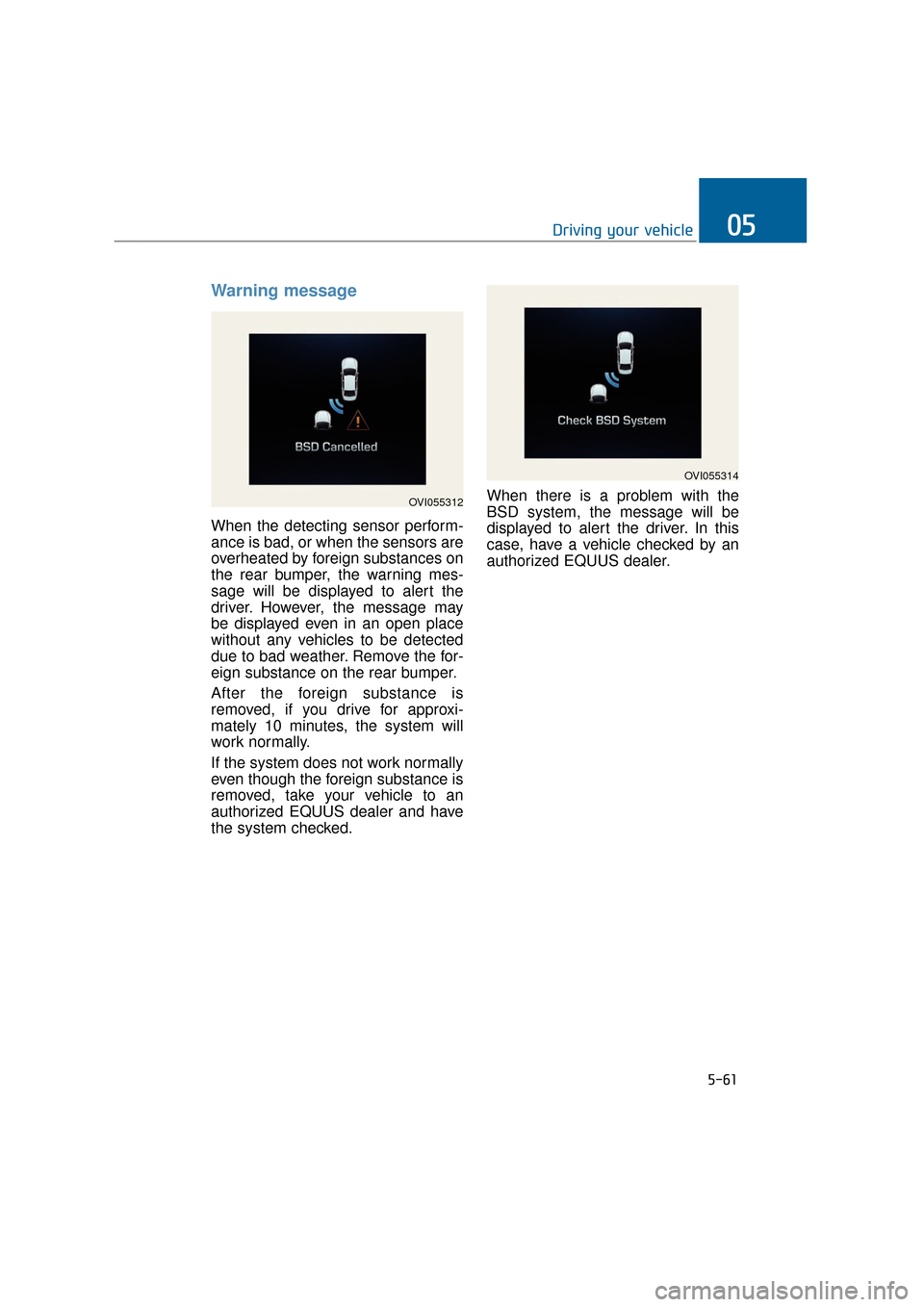
Warning message
When the detecting sensor perform-
ance is bad, or when the sensors are
overheated by foreign substances on
the rear bumper, the warning mes-
sage will be displayed to alert the
driver. However, the message may
be displayed even in an open place
without any vehicles to be detected
due to bad weather. Remove the for-
eign substance on the rear bumper.
After the foreign substance is
removed, if you drive for approxi-
mately 10 minutes, the system will
work normally.
If the system does not work normally
even though the foreign substance is
removed, take your vehicle to an
authorized EQUUS dealer and have
the system checked.When there is a problem with the
BSD system, the message will be
displayed to alert the driver. In this
case, have a vehicle checked by an
authorized EQUUS dealer.
5-61
Driving your vehicle05
OVI055312
OVI055314
Page 313 of 477
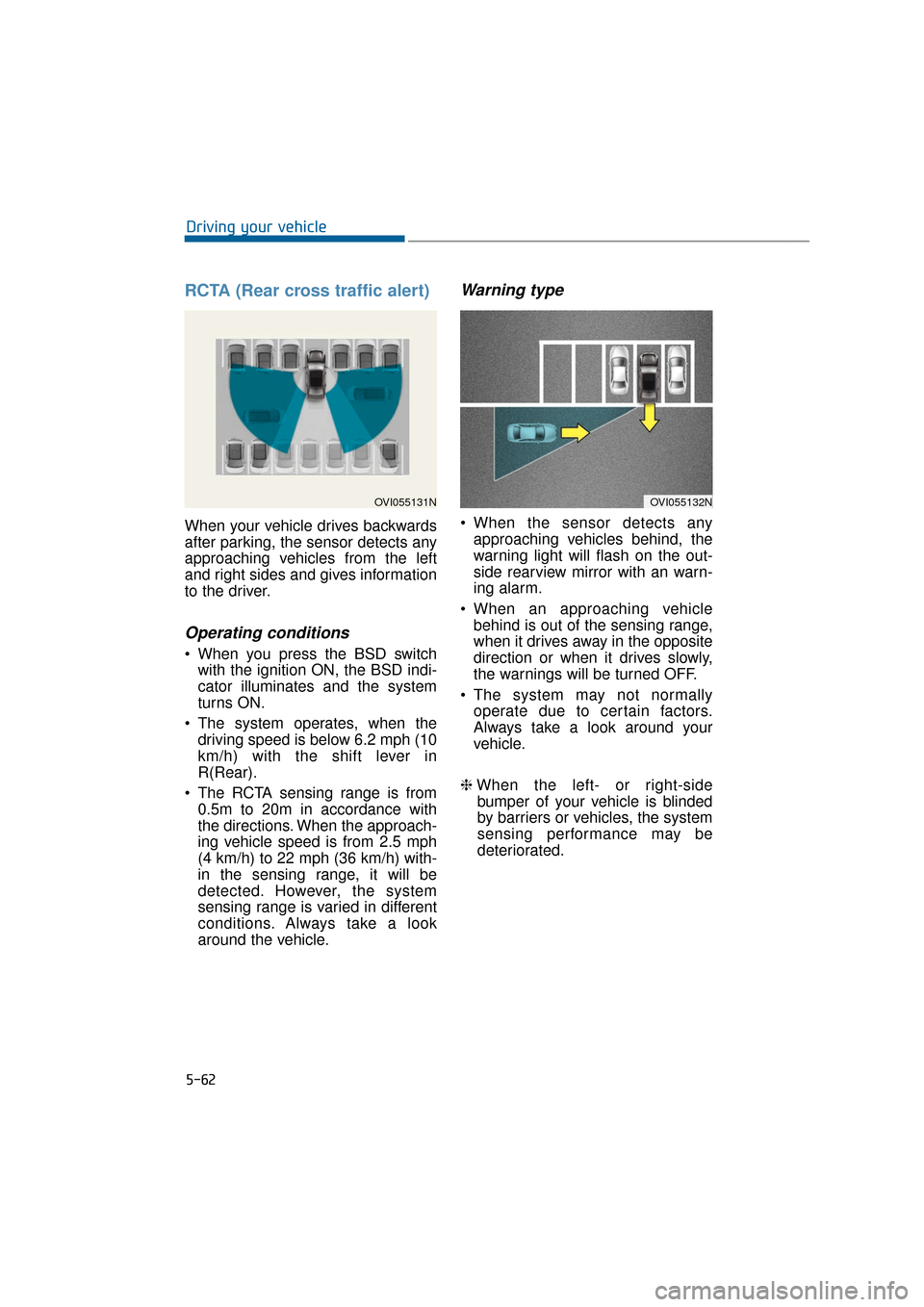
RCTA (Rear cross traffic alert)
When your vehicle drives backwards
after parking, the sensor detects any
approaching vehicles from the left
and right sides and gives information
to the driver.
Operating conditions
When you press the BSD switchwith the ignition ON, the BSD indi-
cator illuminates and the system
turns ON.
The system operates, when the driving speed is below 6.2 mph (10
km/h) with the shift lever in
R(Rear).
The RCTA sensing range is from 0.5m to 20m in accordance with
the directions. When the approach-
ing vehicle speed is from 2.5 mph
(4 km/h) to 22 mph (36 km/h) with-
in the sensing range, it will be
detected. However, the system
sensing range is varied in different
conditions. Always take a look
around the vehicle.
Warning type
When the sensor detects anyapproaching vehicles behind, the
warning light will flash on the out-
side rearview mirror with an warn-
ing alarm.
When an approaching vehicle behind is out of the sensing range,
when it drives away in the opposite
direction or when it drives slowly,
the warnings will be turned OFF.
The system may not normally operate due to certain factors.
Always take a look around your
vehicle.
❈ When the left- or right-side
bumper of your vehicle is blinded
by barriers or vehicles, the system
sensing performance may be
deteriorated.
5-62
Driving your vehicle
OVI055132NOVI055131N
Page 314 of 477
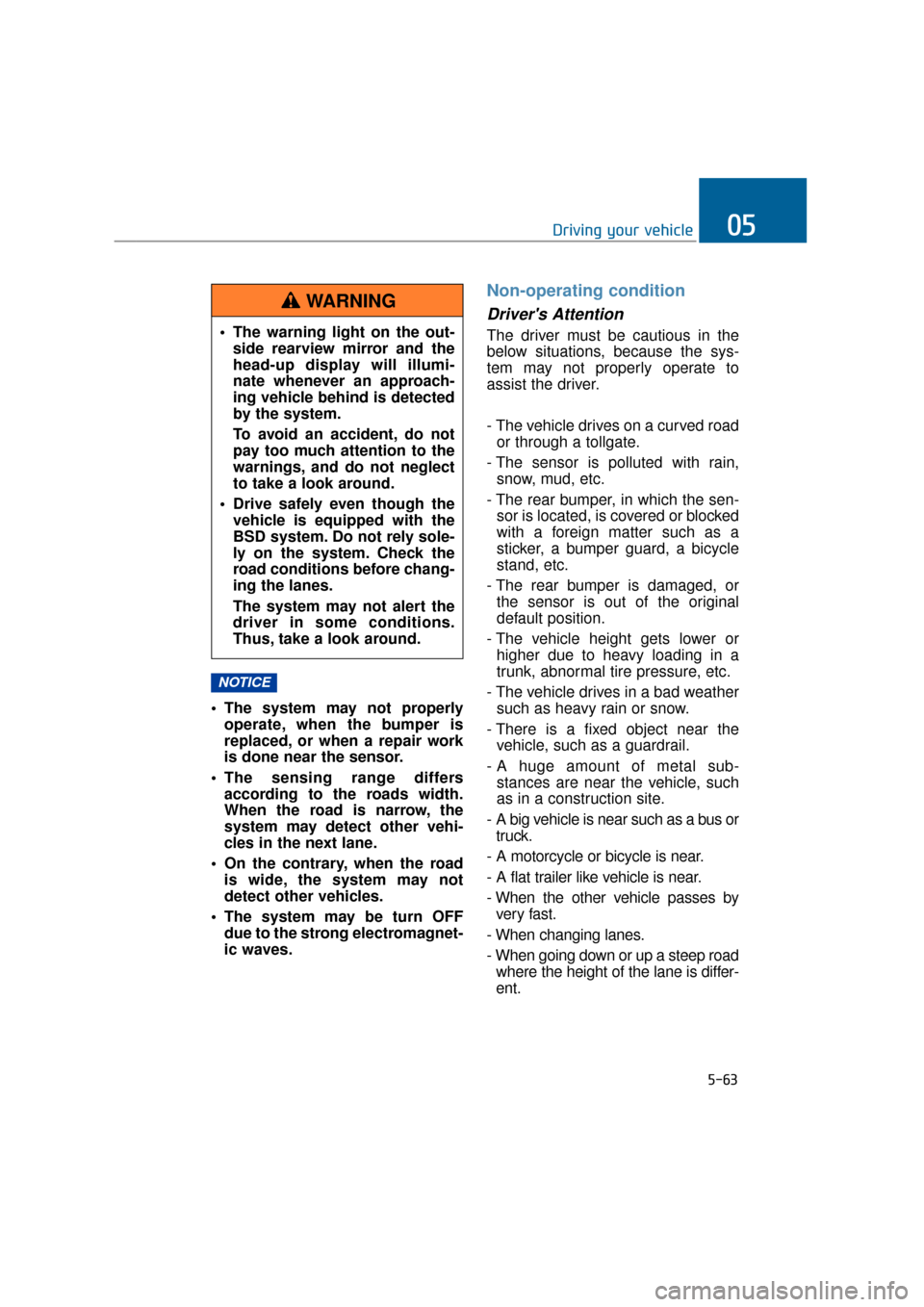
The system may not properlyoperate, when the bumper is
replaced, or when a repair work
is done near the sensor.
The sensing range differs according to the roads width.
When the road is narrow, the
system may detect other vehi-
cles in the next lane.
On the contrary, when the road is wide, the system may not
detect other vehicles.
The system may be turn OFF due to the strong electromagnet-
ic waves.
Non-operating condition
Driver's Attention
The driver must be cautious in the
below situations, because the sys-
tem may not properly operate to
assist the driver.
- The vehicle drives on a curved roador through a tollgate.
- The sensor is polluted with rain, snow, mud, etc.
- The rear bumper, in which the sen- sor is located, is covered or blocked
with a foreign matter such as a
sticker, a bumper guard, a bicycle
stand, etc.
- The rear bumper is damaged, or the sensor is out of the original
default position.
- The vehicle height gets lower or higher due to heavy loading in a
trunk, abnormal tire pressure, etc.
- The vehicle drives in a bad weather such as heavy rain or snow.
- There is a fixed object near the vehicle, such as a guardrail.
- A huge amount of metal sub- stances are near the vehicle, such
as in a construction site.
- A big vehicle is near such as a bus or truck.
- A motorcycle or bicycle is near.
- A flat trailer like vehicle is near.
- When the other vehicle passes by very fast.
- When changing lanes.
- When going down or up a steep road where the height of the lane is differ-
ent.
NOTICE
5-63
Driving your vehicle05
The warning light on the out- side rearview mirror and the
head-up display will illumi-
nate whenever an approach-
ing vehicle behind is detected
by the system.
To avoid an accident, do not
pay too much attention to the
warnings, and do not neglect
to take a look around.
Drive safely even though the vehicle is equipped with the
BSD system. Do not rely sole-
ly on the system. Check the
road conditions before chang-
ing the lanes.
The system may not alert the
driver in some conditions.
Thus, take a look around.
WARNING
Page 315 of 477
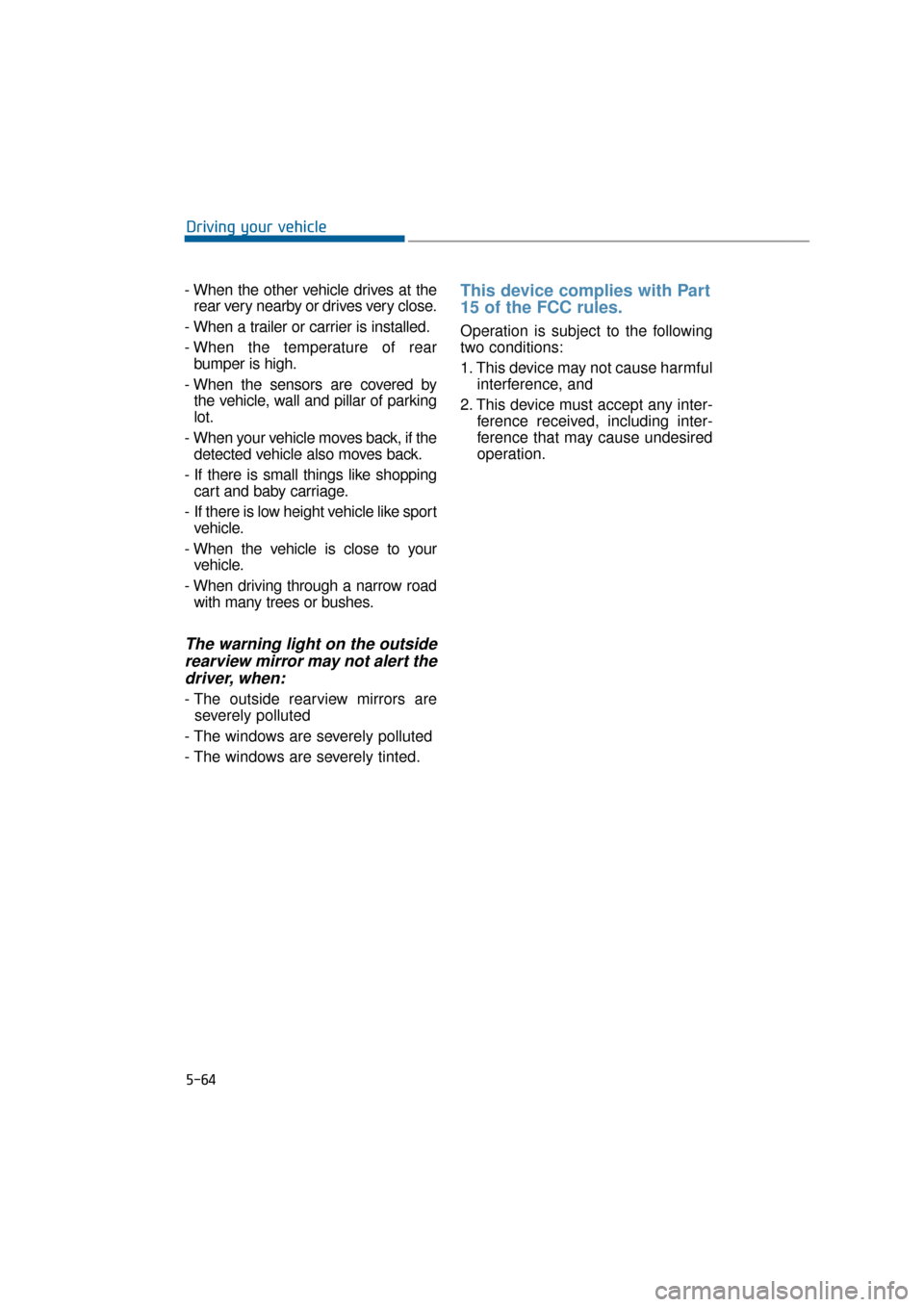
- When the other vehicle drives at therear very nearby or drives very close.
- When a trailer or carrier is installed.
- When the temperature of rear bumper is high.
- When the sensors are covered by the vehicle, wall and pillar of parking
lot.
- When your vehicle moves back, if the detected vehicle also moves back.
- If there is small things like shopping cart and baby carriage.
- If there is low height vehicle like sport vehicle.
- When the vehicle is close to your vehicle.
- When driving through a narrow road with many trees or bushes.
The warning light on the outsiderearview mirror may not alert thedriver, when:
- The outside rearview mirrors are
severely polluted
- The windows are severely polluted
- The windows are severely tinted.
This device complies with Part
15 of the FCC rules.
Operation is subject to the following
two conditions:
1. This device may not cause harmful interference, and
2. This device must accept any inter- ference received, including inter-
ference that may cause undesired
operation.
5-64
Driving your vehicle
Page 316 of 477
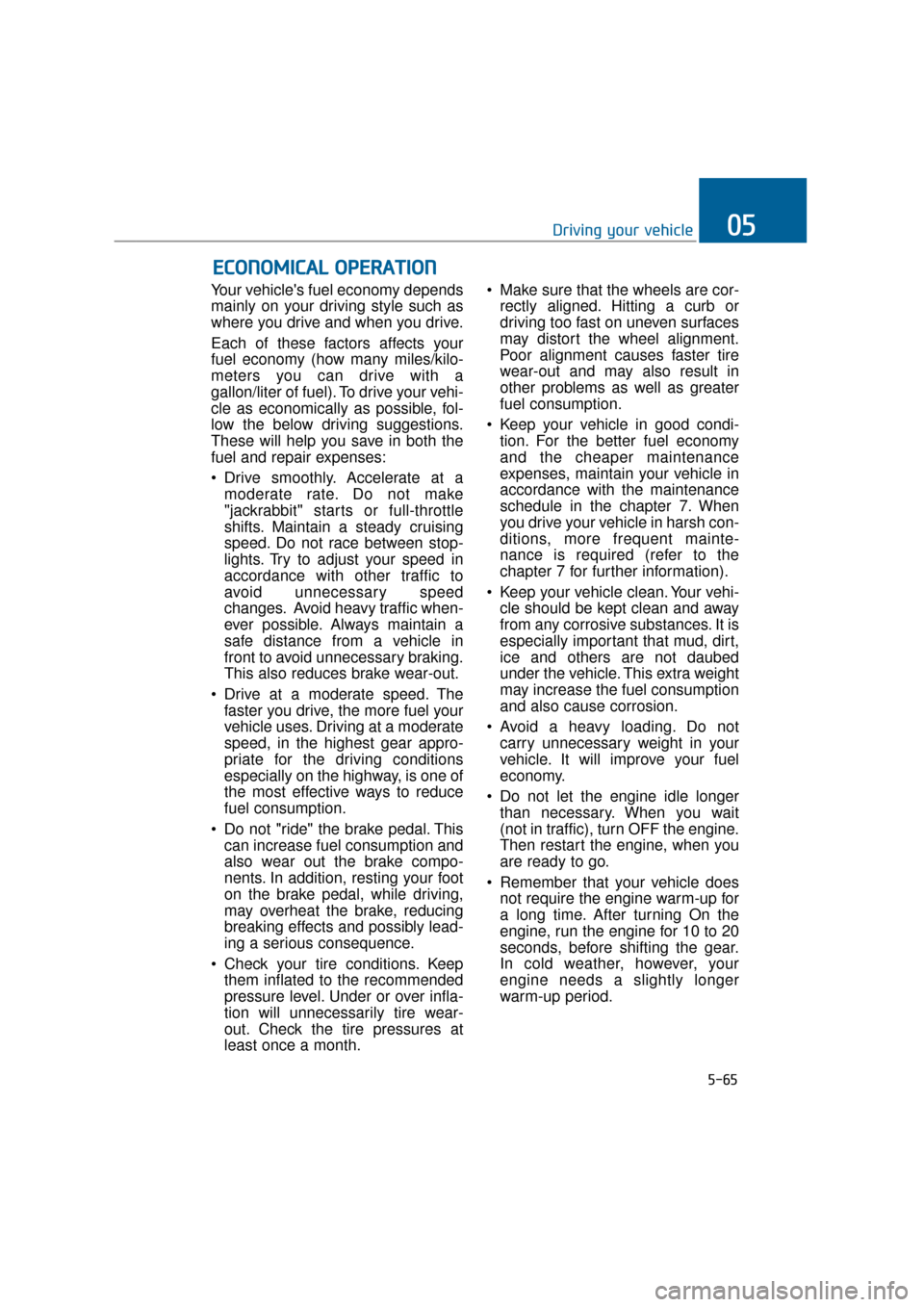
5-65
Driving your vehicle05
Your vehicle's fuel economy depends
mainly on your driving style such as
where you drive and when you drive.
Each of these factors affects your
fuel economy (how many miles/kilo-
meters you can drive with a
gallon/liter of fuel). To drive your vehi-
cle as economically as possible, fol-
low the below driving suggestions.
These will help you save in both the
fuel and repair expenses:
Drive smoothly. Accelerate at amoderate rate. Do not make
"jackrabbit" starts or full-throttle
shifts. Maintain a steady cruising
speed. Do not race between stop-
lights. Try to adjust your speed in
accordance with other traffic to
avoid unnecessary speed
changes. Avoid heavy traffic when-
ever possible. Always maintain a
safe distance from a vehicle in
front to avoid unnecessary braking.
This also reduces brake wear-out.
Drive at a moderate speed. The faster you drive, the more fuel your
vehicle uses. Driving at a moderate
speed, in the highest gear appro-
priate for the driving conditions
especially on the highway, is one of
the most effective ways to reduce
fuel consumption.
Do not "ride" the brake pedal. This can increase fuel consumption and
also wear out the brake compo-
nents. In addition, resting your foot
on the brake pedal, while driving,
may overheat the brake, reducing
breaking effects and possibly lead-
ing a serious consequence.
Check your tire conditions. Keep them inflated to the recommended
pressure level. Under or over infla-
tion will unnecessarily tire wear-
out. Check the tire pressures at
least once a month. Make sure that the wheels are cor-
rectly aligned. Hitting a curb or
driving too fast on uneven surfaces
may distort the wheel alignment.
Poor alignment causes faster tire
wear-out and may also result in
other problems as well as greater
fuel consumption.
Keep your vehicle in good condi- tion. For the better fuel economy
and the cheaper maintenance
expenses, maintain your vehicle in
accordance with the maintenance
schedule in the chapter 7. When
you drive your vehicle in harsh con-
ditions, more frequent mainte-
nance is required (refer to the
chapter 7 for further information).
Keep your vehicle clean. Your vehi- cle should be kept clean and away
from any corrosive substances. It is
especially important that mud, dirt,
ice and others are not daubed
under the vehicle. This extra weight
may increase the fuel consumption
and also cause corrosion.
Avoid a heavy loading. Do not carry unnecessary weight in your
vehicle. It will improve your fuel
economy.
Do not let the engine idle longer than necessary. When you wait
(not in traffic), turn OFF the engine.
Then restart the engine, when you
are ready to go.
Remember that your vehicle does not require the engine warm-up for
a long time. After turning On the
engine, run the engine for 10 to 20
seconds, before shifting the gear.
In cold weather, however, your
engine needs a slightly longer
warm-up period.
E EC
CO
O N
NO
O M
M I
IC
C A
A L
L
O
O P
PE
ER
R A
A T
TI
IO
O N
N
Page 317 of 477
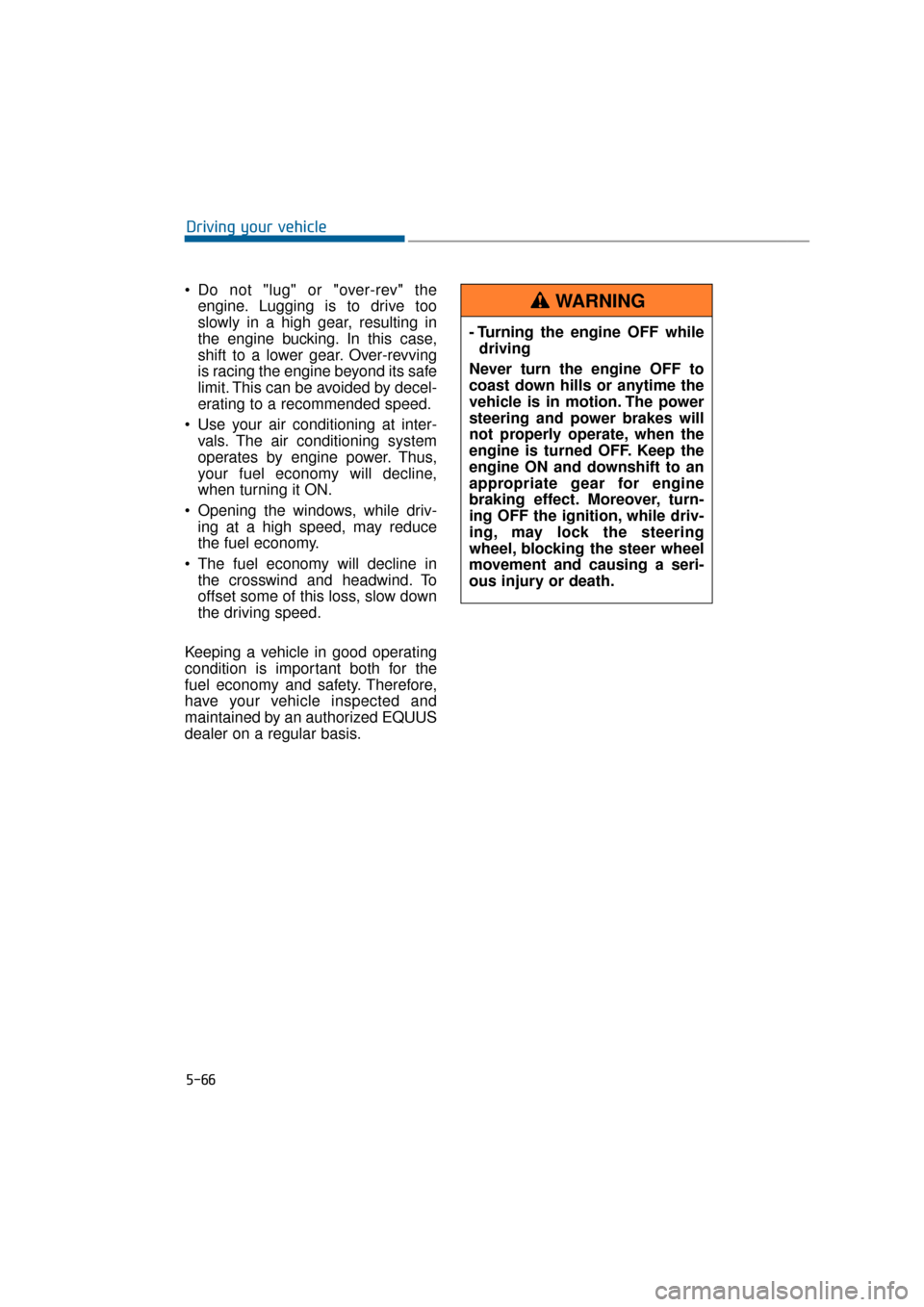
5-66
Driving your vehicle
Do not "lug" or "over-rev" the engine. Lugging is to drive too
slowly in a high gear, resulting in
the engine bucking. In this case,
shift to a lower gear. Over-revving
is racing the engine beyond its safe
limit. This can be avoided by decel-
erating to a recommended speed.
Use your air conditioning at inter- vals. The air conditioning system
operates by engine power. Thus,
your fuel economy will decline,
when turning it ON.
Opening the windows, while driv- ing at a high speed, may reduce
the fuel economy.
The fuel economy will decline in the crosswind and headwind. To
offset some of this loss, slow down
the driving speed.
Keeping a vehicle in good operating
condition is important both for the
fuel economy and safety. Therefore,
have your vehicle inspected and
maintained by an authorized EQUUS
dealer on a regular basis. - Turning the engine OFF while
driving
Never turn the engine OFF to
coast down hills or anytime the
vehicle is in motion. The power
steering and power brakes will
not properly operate, when the
engine is turned OFF. Keep the
engine ON and downshift to an
appropriate gear for engine
braking effect. Moreover, turn-
ing OFF the ignition, while driv-
ing, may lock the steering
wheel, blocking the steer wheel
movement and causing a seri-
ous injury or death.
WARNING
Page 318 of 477
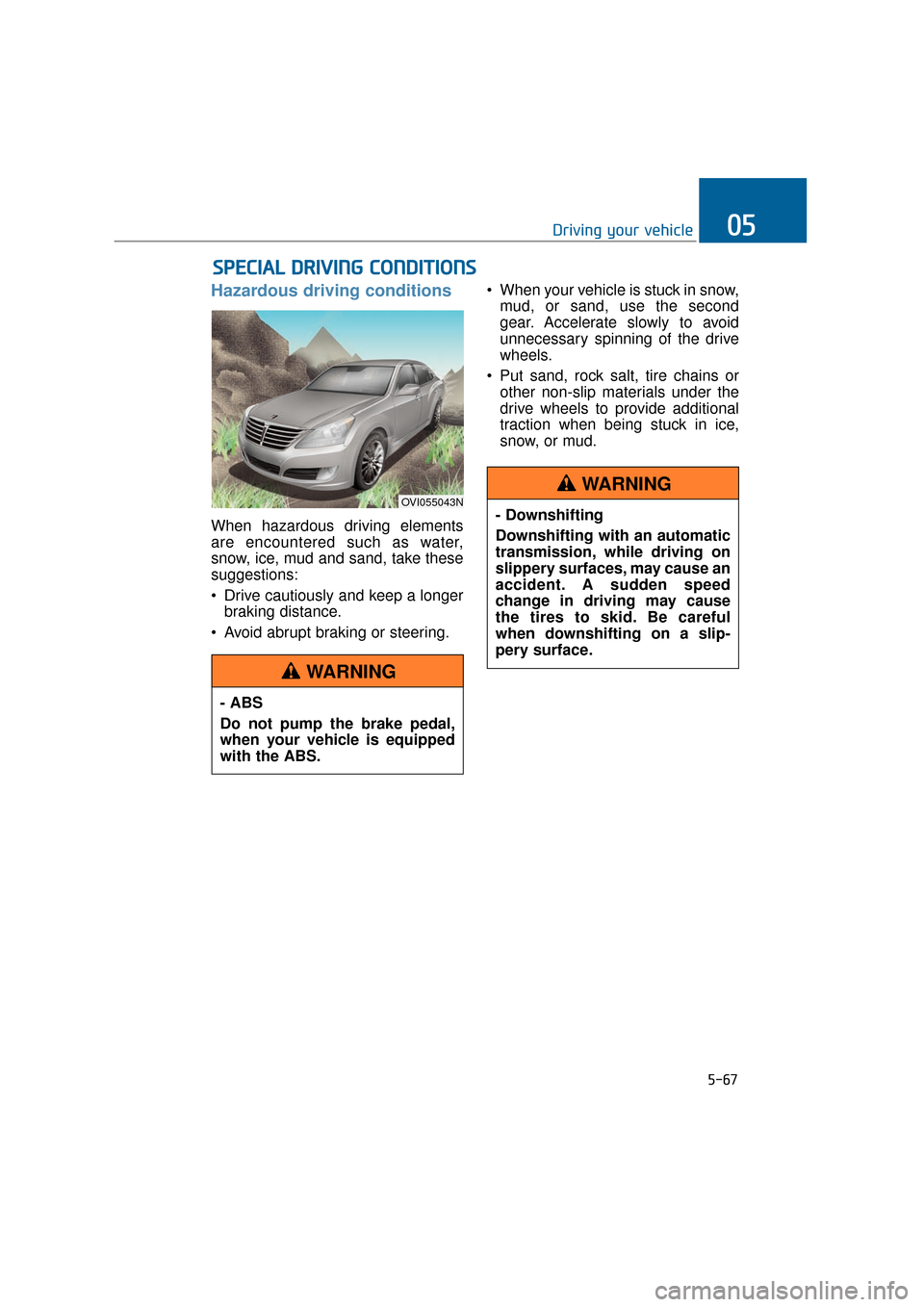
5-67
Driving your vehicle05
Hazardous driving conditions
When hazardous driving elements
are encountered such as water,
snow, ice, mud and sand, take these
suggestions:
Drive cautiously and keep a longerbraking distance.
Avoid abrupt braking or steering. When your vehicle is stuck in snow,
mud, or sand, use the second
gear. Accelerate slowly to avoid
unnecessary spinning of the drive
wheels.
Put sand, rock salt, tire chains or other non-slip materials under the
drive wheels to provide additional
traction when being stuck in ice,
snow, or mud.
S SP
P E
EC
CI
IA
A L
L
D
D R
RI
IV
V I
IN
N G
G
C
C O
O N
ND
DI
IT
T I
IO
O N
NS
S
OVI055043N
- ABS
Do not pump the brake pedal,
when your vehicle is equipped
with the ABS.
WARNING
- Downshifting
Downshifting with an automatic
transmission, while driving on
slippery surfaces, may cause an
accident. A sudden speed
change in driving may cause
the tires to skid. Be careful
when downshifting on a slip-
pery surface.
WARNING
Page 319 of 477
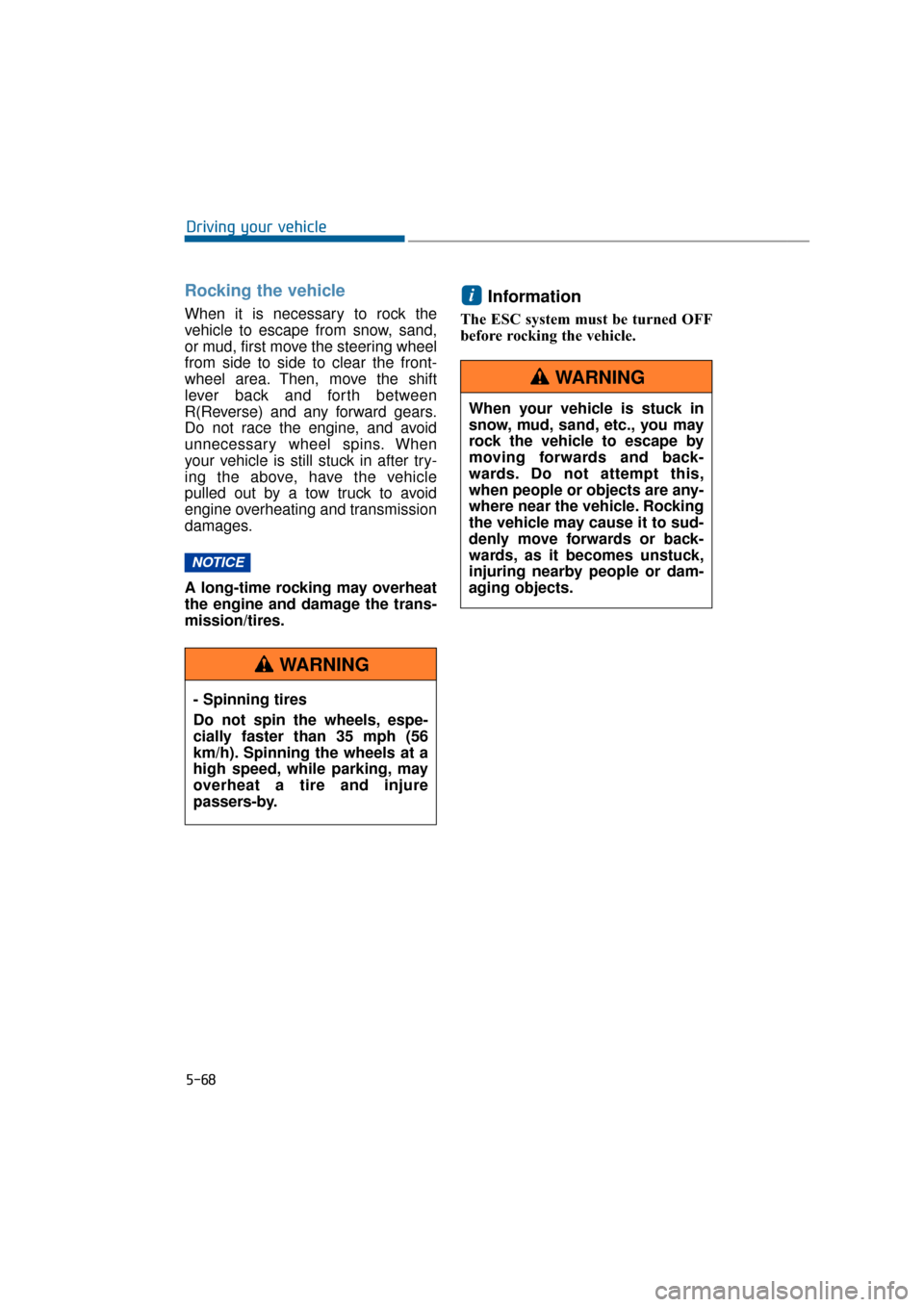
5-68
Driving your vehicle
Rocking the vehicle
When it is necessary to rock the
vehicle to escape from snow, sand,
or mud, first move the steering wheel
from side to side to clear the front-
wheel area. Then, move the shift
lever back and forth between
R(Reverse) and any forward gears.
Do not race the engine, and avoid
unnecessary wheel spins. When
your vehicle is still stuck in after try-
ing the above, have the vehicle
pulled out by a tow truck to avoid
engine overheating and transmission
damages.
A long-time rocking may overheat
the engine and damage the trans-
mission/tires.
Information
The ESC system must be turned OFF
before rocking the vehicle.
i
NOTICE
- Spinning tires
Do not spin the wheels, espe-
cially faster than 35 mph (56
km/h). Spinning the wheels at a
high speed, while parking, may
overheat a tire and injure
passers-by.
WARNING
When your vehicle is stuck in
snow, mud, sand, etc., you may
rock the vehicle to escape by
moving forwards and back-
wards. Do not attempt this,
when people or objects are any-
where near the vehicle. Rocking
the vehicle may cause it to sud-
denly move forwards or back-
wards, as it becomes unstuck,
injuring nearby people or dam-
aging objects.
WARNING
Page 320 of 477
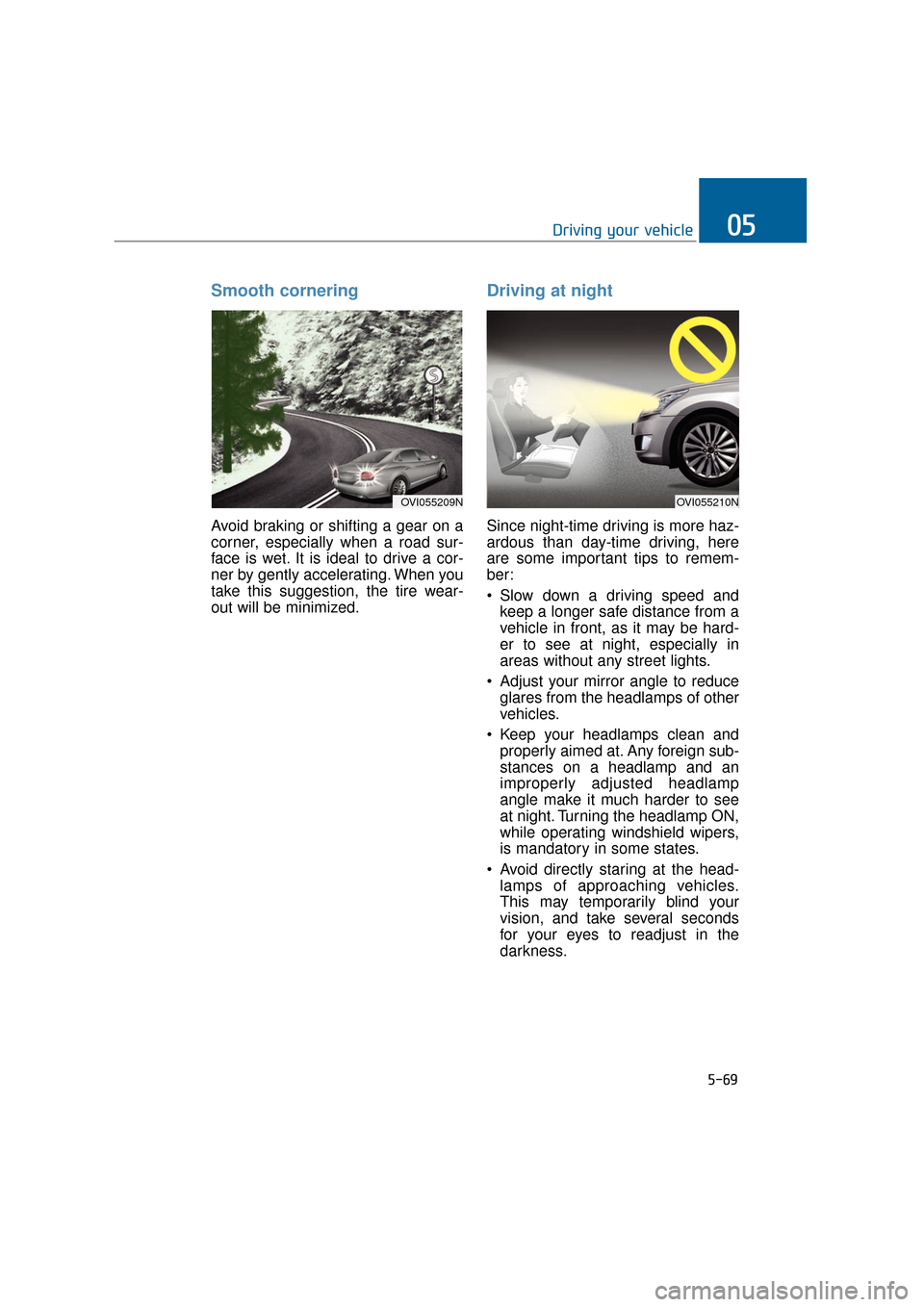
5-69
Driving your vehicle05
Smooth cornering
Avoid braking or shifting a gear on a
corner, especially when a road sur-
face is wet. It is ideal to drive a cor-
ner by gently accelerating. When you
take this suggestion, the tire wear-
out will be minimized.
Driving at night
Since night-time driving is more haz-
ardous than day-time driving, here
are some important tips to remem-
ber:
Slow down a driving speed andkeep a longer safe distance from a
vehicle in front, as it may be hard-
er to see at night, especially in
areas without any street lights.
Adjust your mirror angle to reduce glares from the headlamps of other
vehicles.
Keep your headlamps clean and properly aimed at. Any foreign sub-
stances on a headlamp and an
improperly adjusted headlamp
angle make it much harder to see
at night. Turning the headlamp ON,
while operating windshield wipers,
is mandatory in some states.
Avoid directly staring at the head- lamps of approaching vehicles.
This may temporarily blind your
vision, and take several seconds
for your eyes to readjust in the
darkness.
OVI055209NOVI055210N